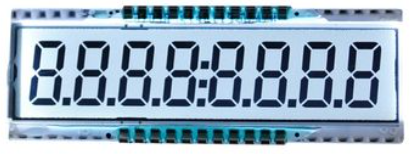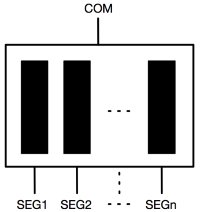
Have you ever looked at a device that shows numbers, symbols, or clear indicators? Chances are, it uses an LCD screen. LCDs are everywhere — from watches to microwave ovens. They play a vital role in turning complex images into simple info.
Not all LCDs are the same. Some work with full graphics, while others focus on basic information. One common type is the segmented LCD screen. It’s known for being simple, effective, and low-cost. Understanding what a segmented LCD is can help you design better gadgets or choose the right display for your project.

Segmented LCD screens are displays made up of separate parts called "segments". Think of these segments as separate puzzle pieces. Each piece can be turned on or off to display numbers, letters, or symbols. Unlike full-graphic screens, these displays cannot display detailed images or complex patterns.
Specifically, the patterns on segmented LCD screens are etched directly onto the glass through a film mold, which means that the text can only be turned on and off, and cannot be converted into other Chinese characters or images. For example, the number "8" on a segmented LCD screen is actually made up of seven small segments, and the display of the numbers 0 to 9 is achieved by controlling the light and off of these seven segments.
Segments are fixed shapes, such as blocks, circles, or arrows. When combined, they form meaningful symbols. For example, a digital clock uses segments for numbers and little icons. These screens are designed for quick info delivery with minimal fuss.
Segment LCD screen is a liquid crystal display technology that uses electric field effect. It consists of a liquid crystal screen, a control circuit and a backlight source. The LCD screen contains many liquid crystal units, each of which has an electrode pair (substrate electrode and conductive glass electrode) and a liquid crystal material. The arrangement of liquid crystal molecules is controlled by controlling the change of the electric field to achieve the display effect.
The working principle of the segment code LCD screen is as follows:
Voltage action: When no voltage is applied to the liquid crystal unit, the liquid crystal molecules exist in a random arrangement and no optical effect is produced.
Voltage change: When voltage is applied, the electric field acts on the liquid crystal molecules, causing their arrangement to change. The arrangement of liquid crystal molecules depends on the magnitude and direction of the applied voltage.
Optical effect: By changing the magnitude and direction of the voltage, the directional arrangement of liquid crystal molecules can be achieved, thereby achieving the effect of controlling the passage of light. When the liquid crystal molecules are arranged in a specific direction, light can pass through the LCD screen and produce a display effect.
A segmented LCD relies on special liquid crystals inside tiny chambers. When voltage passes through these crystals, they change alignment. This change affects how light passes through the display.
Here’s a simplified way to think about it: the control circuit sends electricity to specific segments. Those segments then appear or disappear. Because of this, the display can show messages or indicators. The physics behind it involves controlling light passage without any backlight — making it very energy-efficient.

A typical segmented LCD includes:
· Segments: The actual shapes that display numbers or symbols.
· Backplane: A common electrode running behind all segments.
· Electrodes: Tiny conducting parts that control each segment individually.
· Controller circuitry: The brain that tells which segments to turn on or off.
Manufacturers usually build these parts with plastic, metal, or special glass. The simplicity of the design helps keep costs low and durability high, even in tough conditions.
Segmented LCDs are inexpensive to produce and easy to incorporate into small devices. You won’t need complex software or high-end hardware. This makes them perfect for devices that only need basic info displays.
Since they don’t require a lot of power, segmented LCDs work well with batteries. Devices like watches and calculators run for months on a single charge because these screens consume minimal energy.
Segmented LCD screens can withstand harsh environments. They resist vibrations, temperature swings, and exposure to dust or moisture. That’s why you find them in outdoor equipment and industrial tools.
The high contrast of these screens makes information easy to read in various lighting. Whether you’re outdoors or in a poorly lit room, segments remain clear and bright. They’re excellent for critical readouts like warning lights or measurement displays.
Since segment LCD screens are fixed shapes, you can't easily create detailed images or custom fonts. If you want to display complex graphics or animations, these screens won't do the job. Segment LCDs have advantages such as fast response, high contrast, low cost, low power consumption, small size, low radiation, and are easy to control and customize. Compared with dot matrix LCDs, segment LCDs have limited functionality.
Creating new segment patterns means designing specific masks and manufacturing new molds. This process is costly and time-consuming, making it tough to update the display later.
While great for simple info, they struggle with rapidly changing data or multiple messages at once. The limited number of segments means fewer options for showing varied content.
You’ll see segmented LCDs in many everyday gadgets. Think of digital watches, scientific calculators, or remote controls. They display numbers, battery levels, or basic symbols reliably.
Dashboards often use these screens for warning lights or speed indicators. Industrial machinery rely on segmented LCDs for status updates, temperature readings, or control settings.
Lightweight and durable, segmented LCDs fit well in medical monitors or diagnostic tools. They show vital signs, levels, or alerts without draining power.
Next-gen fitness trackers, smart home devices, or appliances often use segmented LCDs. Their low cost and longevity make them ideal for budget-friendly tech or custom projects.
Manufacturers are developing new manufacturing techniques. These innovations allow for more complex segment shapes and configurations. Some are experimenting with combining segmented LCDs with other screens to get better graphics.
Segmented LCDs remain popular in sectors where cost and durability outweigh graphic complexity. Experts predict they’ll see increased use in IoT gadgets due to their low power needs.
A segmented LCD screen is a simple yet effective display technology. It uses parts called segments to show numbers, symbols, or simple graphics. These displays excel in cost, power efficiency, and durability.
While they have limitations in detail and flexibility, their strength lies in reliability and straightforward info delivery. They’re perfect for devices that need constant, clear, and quick communication — from watches to industrial controls.
Understanding the core attributes of segmented LCDs helps you choose the right display for your project or product. By matching features with needs, you can create better devices and improve user experience.
Name: lily
Mobile:185 7332 9919
Tel:185 7332 9919
Whatsapp:8618573329919
Email:sales@huayuan-lcd.com
Add:Factory No.9, Zhongnan High-tech Intelligent Manufacturing Industrial Park, Tianyuan District, Zhuzhou,Hunan, China, 412000